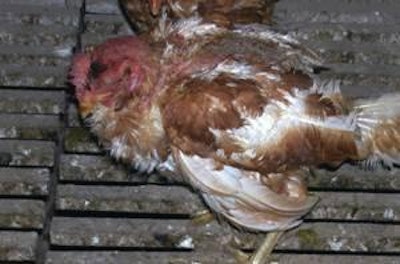
From time to time Egg Industry will describe a common or emerging problem which impacts production or quality. It is hoped that readers will respond with comments and suggestions which will be shared in subsequent issues.
Exercise January
Situation: Cannibalism in brown-feathered laying flocks housed in broiler breeder units with slats and litter.
History and observations: Two flocks in adjacent houses, each comprising 16,000 hens. Flocks allowed 1.5 ft2 of floor area/hen at 16 week transfer. Standard hen-housed egg production, livability, feed conversion and egg mass were recorded through week 38 week. At this time mortality increased sharply from 0.1% per week to over 1.0% in week 41. Hen-week egg production declined by 20% over the period.
The flock was extremely “flighty.” Hens showed variation in beak trim from complete re-growth to removal of the tip of the maxillary beak, consistent with beak treatment at the hatchery with no subsequent trim. Approximately 5% of the flock was perching on nest modules and the egg collection rail. These birds showed lacerations of the skin surrounding the vent and contusions of the head and neck. Most of the hens on nest boxes were not in production and were appreciably lighter in weight (2.8 lbs) compared to the remainder of the flock with many showing obvious emaciation. Examination of the collected daily mortality confirmed vent peck with evisceration.
The atmosphere in the house was extremely dusty consistent with flurries of bird movement.
By the time of the evaluation, production had returned to standard and the weekly losses had stabilized at 0.5% since week 50. Given that these were organic flocks with a potential contribution margin (revenue minus direct costs) of approximately $1 per dozen, losses to 60 weeks amounted to $32,000. It is estimated that by week 75 depletion, given the projected mortality, suboptimal egg production and low case weight cumulative losses of eggs on a hen-housed basis would amount to 30 eggs per hen. This would represent a potential loss of $75,000 for the two flocks.

















